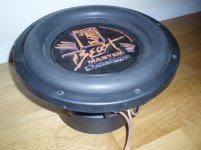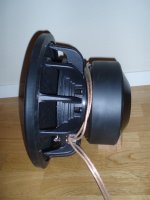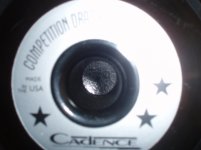S2 should be Sd/4. Too high a compression ratio is rough on drivers and also makes it hard to install a driver. That is one of the drawbacks with this particular driver, but since you have it, let's try to work around it.
Look closely at the criteria posted by MaVo in post 14, it has two different tapers, a slow taper near the throat, a faster rate nearer the mouth. This is one way to minimize the ripples.
thanks for the tip.
BTW, WT2 left USA territory yesterday!
oh and when using the wizard don't forget to try the fixed and variable options.
thanks, good to know when working on it.
I got plans for the acousta 116's coming.
Possibly found some place to supply MDF for Acousta's and subwoofer.
I'll be back.
Driver database
If you want high maximum output at low frequencies then you need lots of volume displacement in any enclosure, tapped horns are no different. For the many drivers I've tried, at a given power input the required Xmax is similar for all enclosures with the same cutoff frequency (reflex, bandpass, tapped horn) but the efficiency (and maximum output) is lowest for reflex and highest for tapped horn.
I've put together a database of drivers showing maximum SPL limited by efficiency and Xmax, targeted at 31Hz cutoff (low B on a 5-string bass), showing the main physical parameters that limit output -- you can download OpenOffice and Excel versions of it from here:
Index of /temp
The drivers are sorted by the lower of Pe and Xmax limited output -- "red" drivers don't have enough Xmax for full power down to 30Hz, "yellow" ones have too much (and lower efficiency), the F3_tune column shows the box -3dB frequency where the Pe and Xmax limited outputs are equal.
Of course if you don't want to sustain maximum sinewave output down to cutoff, a driver with higher efficiency and lower Xmax will give hiogher peak SPL, but I don't like this approach.
None of this tells you which drivers will give a flat response in a given box, you need to try a design for that. But it does show which drivers are a good starting point for a given cutoff frequency if you want maximum SPL.
Ian
Well the higher the better for Xmax you want at least 5mm but some woofers have as much as 18mm so I guess it all depends on what you have available. the highest Q I would consider good is .35 but as before the lower the better I just found a driver with a .20 so that is fantastic. As for Vas I guess it just depends how big you can make your box. A good TH that gets nice and low could end up having a volume 3 or 4 X Vas.
If you want high maximum output at low frequencies then you need lots of volume displacement in any enclosure, tapped horns are no different. For the many drivers I've tried, at a given power input the required Xmax is similar for all enclosures with the same cutoff frequency (reflex, bandpass, tapped horn) but the efficiency (and maximum output) is lowest for reflex and highest for tapped horn.
I've put together a database of drivers showing maximum SPL limited by efficiency and Xmax, targeted at 31Hz cutoff (low B on a 5-string bass), showing the main physical parameters that limit output -- you can download OpenOffice and Excel versions of it from here:
Index of /temp
The drivers are sorted by the lower of Pe and Xmax limited output -- "red" drivers don't have enough Xmax for full power down to 30Hz, "yellow" ones have too much (and lower efficiency), the F3_tune column shows the box -3dB frequency where the Pe and Xmax limited outputs are equal.
Of course if you don't want to sustain maximum sinewave output down to cutoff, a driver with higher efficiency and lower Xmax will give hiogher peak SPL, but I don't like this approach.
None of this tells you which drivers will give a flat response in a given box, you need to try a design for that. But it does show which drivers are a good starting point for a given cutoff frequency if you want maximum SPL.
Ian
None of this tells you which drivers will give a flat response in a given box, you need to try a design for that.Ian
Typically lower Qts will give you the potential for a flatter response.
So, my driver is on the high side on the Qts side? I hope it will measure a lower value with Woofer Tester 2.Typically lower Qts will give you the potential for a flatter response.
I got the Beastmaster from my parents house today, ready for WT2.
Btw, when I get the "perfect" lengthe for the cabinet, do anyone want to make plans for me based on that?
Attachments
well .35 is on the high side for a driver very well suited for a tapped horn but its plenty low enough. It should model just fine.
I don't mean any offense, but this is simply not a true statement. There is a lot more than Qts involved in driver suitability. Some of the best drivers I have found thus far have nearly twice the Qts limit you suggest.
For use in a tapped horn, the driver's suspension compliance is critical. The things I consider when evaluating a driver were posted earlier in this thread.
I have modeled them already, as has MaVo. These drivers are not bad for a tapped horn, though, like many drivers they will exceed excursion limits below horn cutoff, making a proper highpass mandatory for higher listening levels.
What do that mean, in other words?...like many drivers they will exceed excursion limits below horn cutoff, making a proper highpass mandatory for higher listening levels.
If you look at the excursion plot in your Hornresp model, you can see that with high power levels at very low frequencies, the driver will want to move quite a bit. Drivers have limits, xmax is the linear range, xlim or xmech is the physical limit of the cone travel.
In a tapped horn, this particular driver will experience high excursion with very low frequencies, which may lead to damage. Might be an issue with you, it might not. I tend to listen loud, and I have bottomed out my drivers in my tapped horns. To avoid this, I use a high-pass filter, an electronic crossover that cuts off the extremely low frequencies.
In a tapped horn, this particular driver will experience high excursion with very low frequencies, which may lead to damage. Might be an issue with you, it might not. I tend to listen loud, and I have bottomed out my drivers in my tapped horns. To avoid this, I use a high-pass filter, an electronic crossover that cuts off the extremely low frequencies.
You can get a lot of bass from a high Qts driver but if you want a flat response and an impulse response that doesn't look like your doctor's signature don't even think about using a driver with a qts above .4. If you don't mind muddy ringing bass or if you can tell the difference you might be satisfied with the results, but once you hear a design with a truly clean response you'll never go back.
Someone gave me the link to this amplifier, THE T.AMP PROLINE 3000, 2x 1500W @ 4 Ohms, 2x 1100W @ 8 Ohms, 2x 1800W @ 2 Ohms.. Weight 37kgs.
If I decide to run only one of the two Beastmasters, it can run 1800W into each coil @ 2ohms. Better WAF with only one driver..
John
Hey dude, is your house wired for 220V? Because by the way, the most you can continually get out of a standard wall circuit is like 1100W. (15Ax120V=1800W but then there's a bunch of derating, I forget exactly).
If the amp has a switch mode power supply, and you use full power just for headroom, and nothing else is connected on that circuit, it might not be an issue. On the other hand if you crank the amp and there's a hair dryer or toaster on the circuit...POP goes the breaker!
Just something to think about.
One problem with pro amps in-home is that they are generally fan cooled non-defeatably and therefore make objectionable noise.
How much does this amp cost?
As for the drivers, they appear to by typical huge-surround car audio subs. Might not really be what you want, but you didn't really explain much about your listening room and size/aesthetic/WAF restrictions...
Hey dude, is your house wired for 220V? Because by the way, the most you can continually get out of a standard wall circuit is like 1100W. (15Ax120V=1800W but then there's a bunch of derating, I forget exactly).
Yep, 220V and 10A circuit.
I've been speaking with a guy in Norway who own one, use it bridged on a 18", Re Audio XXX-18, and he have had a couple of blackouts due to HEAVY volume and low frequencies watching movies, but it's generally not a problem.If the amp has a switch mode power supply, and you use full power just for headroom, and nothing else is connected on that circuit, it might not be an issue. On the other hand if you crank the amp and there's a hair dryer or toaster on the circuit...POP goes the breaker!
One problem with pro amps in-home is that they are generally fan cooled non-defeatably and therefore make objectionable noise.
...He also tell me it make less noice than a Xbox360.
How much does this amp cost?
This amp cost 511euro +shipping and Tax...
As for the drivers, they appear to by typical huge-surround car audio subs. Might not really be what you want, but you didn't really explain much about your..
They might not be a good choice, but I paid $1000 each at a dealer, so I want to try.
..listening room...
Livingroom, open kitchen solution, a hallway.. not a good room for sound.
..and size/aesthetic/...
About 60-70sq. metres "open room".
..WAF restrictions...
Strictly WAF restricted..
There is a digital option, same brand, similar performance, smaller size, prettier, less idle power consumption, more efficient, hopefully less noise? Better pricing, 455euro ++...
http://www.thomann.de/se/the_tamp_d2800.htm
Last edited:
Found a review: T.Amp D Series Power Amplifiers - Ukslc.org
Looks like it doesn't like low loads.. Might not be a good option after all..
Looks like it doesn't like low loads.. Might not be a good option after all..
Unless you have a livingroom the size of the superdome if you're designing your tapped horns anywhere near correctly, you will do damage to your ear drums long before even approaching 200Watts. So this is all moot anyway.
Bet you are right, and I'm not planning to either, just want to be assured that I got enough power reserves for the lower frequencies. (This worry might come from previous car-audio experiences, and how unwilling these drivers was to move...)
So, I believe you. Running one driver, in series net 4ohms. 1ohm is no good.
What about this one: Hypex DS8.0 - dynaBel AS
I've had friends running 0.5Ohm setups too..1 OHM is definitely no good! 8OHMS is even better. Car amp specs that tell you they are 1 OHM stable always fail to mention that you have 10 times the distortion at 1 OHM as you do at 4.
Running one driver, 4Ohms is the most suitable load to use.
When I want to run Woofertester 2 for the tiele parametres, I connect the Voicecoils in series for the test procedure to collect correct data?
I've had friends running 0.5Ohm setups too..
Running one driver, 4Ohms is the most suitable load to use.
When I want to run Woofertester 2 for the tiele parametres, I connect the Voicecoils in series for the test procedure to collect correct data?
Wire the speaker the same way it will be used.
With a DVC driver, I test each coil separately, as well as wired in series and parallel to see which configuration is best suited for what I am trying to do.
Wire the speaker the same way it will be used.
With a DVC driver, I test each coil separately, as well as wired in series and parallel to see which configuration is best suited for what I am trying to do.
I'll have to play a little with it when I receive it, but a lower load than 4ohms cannot be good? Even if it model better? And I cannot use only one VC of the two.
If I choose to run 2drivers on one channel, loads of 2Ohm and 8ohms can be used.
Opinions on one or two drivers in one enclosure? The Hypex DS 8.0 is capable of 530W @ 8Ohms. The enclosure might grow a little large thou..
I'll have to play a little with it when I receive it, but a lower load than 4ohms cannot be good? Even if it model better? And I cannot use only one VC of the two.
The lower the impedance the greater the heat hence the higher the distortion. Typically it is best to use the impedence the amp is rated at. Although many amps rated for 4 Ohms still perform better at 8 Ohms. When an amp states that it is 1 or 2 Ohm stable that simply means that it won't blow up if you run it that way. And the power ratings are very misleading. Just because an amp claims that it has twice the wattage at 2 Ohms as it does at 4 Ohms doesn't mean it's going to give you better sound or even more volume. If the amp is putting out more distortion the voice coils in your speakers heat up quicker and you get more dynamic compression. I know all kinds of people are gonna get in a hissy fit when I say this but running your amp at 1 or even 2 Ohms NEVER sounds better than at 4!! And 8 almost always sounds better than 4 even for a car amp.
- Status
- This old topic is closed. If you want to reopen this topic, contact a moderator using the "Report Post" button.
- Home
- Loudspeakers
- Subwoofers
- Need help, designing TH sub with 2x12" drivers.


